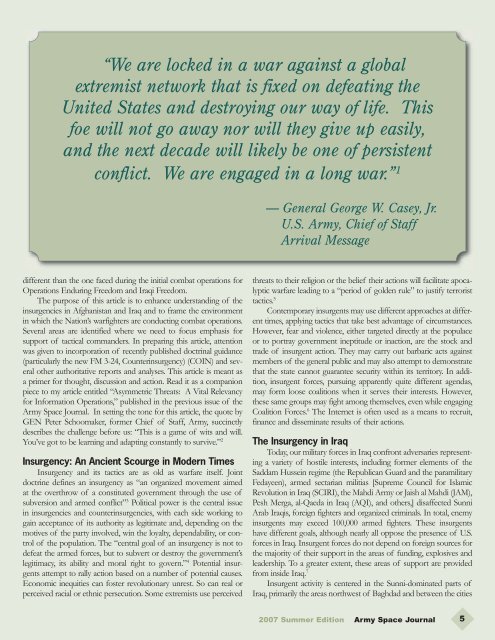Volume 6, Number 3 - Space and Missile Defense Command - U.S. ...
Volume 6, Number 3 - Space and Missile Defense Command - U.S. ...
Volume 6, Number 3 - Space and Missile Defense Command - U.S. ...
You also want an ePaper? Increase the reach of your titles
YUMPU automatically turns print PDFs into web optimized ePapers that Google loves.
“We are locked in a war against a global<br />
extremist network that is fixed on defeating the<br />
United States <strong>and</strong> destroying our way of life. This<br />
foe will not go away nor will they give up easily,<br />
<strong>and</strong> the next decade will likely be one of persistent<br />
conflict. We are engaged in a long war.” 1<br />
— General George W. Casey, Jr.<br />
U.S. Army, Chief of Staff<br />
Arrival Message<br />
different than the one faced during the initial combat operations for<br />
Operations Enduring Freedom <strong>and</strong> Iraqi Freedom.<br />
The purpose of this article is to enhance underst<strong>and</strong>ing of the<br />
insurgencies in Afghanistan <strong>and</strong> Iraq <strong>and</strong> to frame the environment<br />
in which the Nation’s warfighters are conducting combat operations.<br />
Several areas are identified where we need to focus emphasis for<br />
support of tactical comm<strong>and</strong>ers. In preparing this article, attention<br />
was given to incorporation of recently published doctrinal guidance<br />
(particularly the new FM 3-24, Counterinsurgency) (COIN) <strong>and</strong> several<br />
other authoritative reports <strong>and</strong> analyses. This article is meant as<br />
a primer for thought, discussion <strong>and</strong> action. Read it as a companion<br />
piece to my article entitled “Asymmetric Threats: A Vital Relevancy<br />
for Information Operations,” published in the previous issue of the<br />
Army <strong>Space</strong> Journal. In setting the tone for this article, the quote by<br />
GEN Peter Schoomaker, former Chief of Staff, Army, succinctly<br />
describes the challenge before us: “This is a game of wits <strong>and</strong> will.<br />
You’ve got to be learning <strong>and</strong> adapting constantly to survive.” 2<br />
Insurgency: An Ancient Scourge in Modern Times<br />
Insurgency <strong>and</strong> its tactics are as old as warfare itself. Joint<br />
doctrine defines an insurgency as “an organized movement aimed<br />
at the overthrow of a constituted government through the use of<br />
subversion <strong>and</strong> armed conflict” 3 Political power is the central issue<br />
in insurgencies <strong>and</strong> counterinsurgencies, with each side working to<br />
gain acceptance of its authority as legitimate <strong>and</strong>, depending on the<br />
motives of the party involved, win the loyalty, dependability, or control<br />
of the population. The “central goal of an insurgency is not to<br />
defeat the armed forces, but to subvert or destroy the government’s<br />
legitimacy, its ability <strong>and</strong> moral right to govern.” 4 Potential insurgents<br />
attempt to rally action based on a number of potential causes.<br />
Economic inequities can foster revolutionary unrest. So can real or<br />
perceived racial or ethnic persecution. Some extremists use perceived<br />
threats to their religion or the belief their actions will facilitate apocalyptic<br />
warfare leading to a “period of golden rule” to justify terrorist<br />
tactics. 5<br />
Contemporary insurgents may use different approaches at different<br />
times, applying tactics that take best advantage of circumstances.<br />
However, fear <strong>and</strong> violence, either targeted directly at the populace<br />
or to portray government ineptitude or inaction, are the stock <strong>and</strong><br />
trade of insurgent action. They may carry out barbaric acts against<br />
members of the general public <strong>and</strong> may also attempt to demonstrate<br />
that the state cannot guarantee security within its territory. In addition,<br />
insurgent forces, pursuing apparently quite different agendas,<br />
may form loose coalitions when it serves their interests. However,<br />
these same groups may fight among themselves, even while engaging<br />
Coalition Forces. 6 The Internet is often used as a means to recruit,<br />
finance <strong>and</strong> disseminate results of their actions.<br />
The Insurgency in Iraq<br />
Today, our military forces in Iraq confront adversaries representing<br />
a variety of hostile interests, including former elements of the<br />
Saddam Hussein regime (the Republican Guard <strong>and</strong> the paramilitary<br />
Fedayeen), armed sectarian militias [Supreme Council for Islamic<br />
Revolution in Iraq (SCIRI), the Mahdi Army or Jaish al Mahdi (JAM),<br />
Pesh Merga, al-Qaeda in Iraq (AQI), <strong>and</strong> others,] disaffected Sunni<br />
Arab Iraqis, foreign fighters <strong>and</strong> organized criminals. In total, enemy<br />
insurgents may exceed 100,000 armed fighters. These insurgents<br />
have different goals, although nearly all oppose the presence of U.S.<br />
forces in Iraq. Insurgent forces do not depend on foreign sources for<br />
the majority of their support in the areas of funding, explosives <strong>and</strong><br />
leadership. To a greater extent, these areas of support are provided<br />
from inside Iraq. 7<br />
Insurgent activity is centered in the Sunni-dominated parts of<br />
Iraq, primarily the areas northwest of Baghdad <strong>and</strong> between the cities<br />
2007 Summer Edition Army <strong>Space</strong> Journal<br />
5

















